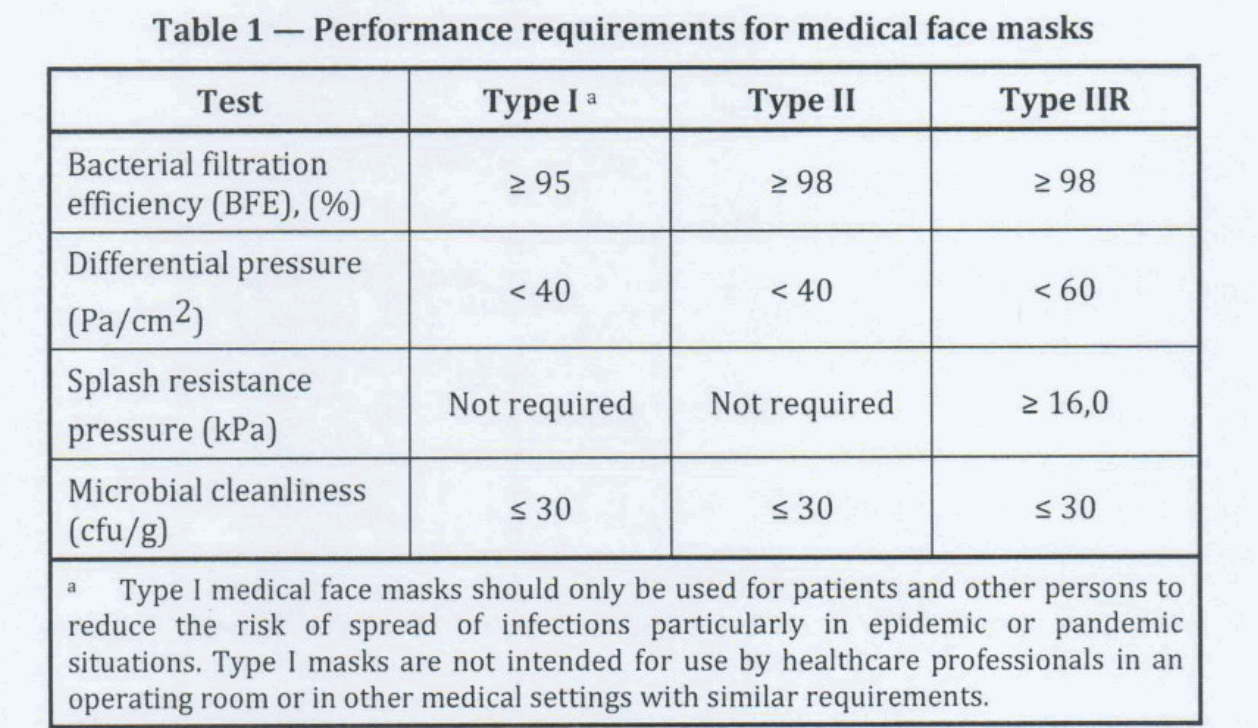Types of face masks
The first step in identifying the face mask to fit your requirements is to know the different types. Medical face masks are broken down into 2 main categories: surgical masks and respirators. Here are some types of masks you might have heard of:
•Type I Face Mask
•Type I R Face Mask
•Type II Face Mask
•Type II R Face Mask
•FFP2 Face Mask
•FFP3 Face Mask
•N95 Face Mask
What’s the difference between Type I and Type II Masks?
Type I, and Type I R face masks have a BFE (bacterial filtration efficiency) of 95%, whereas Type II and Type II R face masks have a BFE of 98%. The breathing resistance, and splash resistance for Type I R and Type II R masks, are exactly the same.
Type I, I R, II and II R face masks are medical masks tested in the direction of exhalation (inside to outside) and take into account the efficiency of bacterial filtration. Surgical masks of this type stop the wearer from infecting the surrounding environment. They are not effective at protecting the wearer from airbourne diseases such as coronavirus.

What is a Type II Face Mask?
Type II face masks (EN14683) are medical face masks made up of a protective 3 ply construction that prevents large particles from reaching the patient or working surfaces, however they are not effective when blood or bodily fluids are present.
Characteristics of Type II face masks include:
Pleat style with ear loops or ties
Protective three-layer construction
Available in a variety of colours and styles.
What is a Type IIR Face Mask?
Type IIR face masks EN14683 are medical face masks made up of a 4 ply construction that prevents large particles from reaching the patient or working surfaces. Type IIR Face masks include a splash resistant layer to protect against blood and other bodily fluids. Type IIR face masks are tested in the direction of exhalation (inside to outside) and take into account the efficiency of bacterial filtration.
Characteristics of Type IIR face masks include:
Pleat style with ear loops or ties
Protective four-layer construction
Available in a variety of colours and styles
Splash resistant layer against bodily fluids.
Type I, Type IR, Type II and Type IIR masks are for use in protecting others from the wearer transmitting infection.
What’s the difference between FFP2 and FFP3 Face Masks?
FFP2 & FFP3 Face Masks are European classes of respirators, tested on the direction of inspiration (outside to inside) and take into account leakage to the face and filtration efficiency.
FFP2 face masks are the equivalent of N95 face masks, which meet the guidelines from The World Health Organisation for protection against Covid-19. FFP2 masks have a minimum of 94% filtration percentage and a maximum of 8% leakage to the inside. These masks are not shaped to your face but are simply held in place by the elastic earloop and have a typical lifespan of 3-8 hours depending on environmental factors.
FFP3 face masks are the most effective at filtration, with a minimum filtration of 99% and a maximum leakage of 2% to the inside. These masks are better shaped to your face for a more snug fit and typically have a valve to help breathe as the filtration material is much thicker. The valve also reduces the build up of moisture, lengthening the lifespan of the mask. FFP3 masks are typically used for handling asbestos.
FFP2, FFP3, N95 and other respirator masks are effective at protecting the wearer from viral transmission.
It should be noted that N95 masks can not be officially legally recommended for use in Europe although in the current situation with PPE shortages in practice a more flexible approach seems to be being taken.
What are the US and European Standards for face masks?
Medical masks and respirators undergo different standards and regulations, dependent on the geographical area to which they are manufactured.
Medical masks in Europe must comply with the European standard EN 14683, which have 3 levels of bacterial filtration efficiency (BFE1, BFE2, Type R). In the US medical masks must comply with ASTM standards, which have three levels of protection (from low risk of exposure to fluids to high risk of exposure to fluids).
Respirators in Europe must meet European standard EN 149: 2001, which includes three classes of disposable particulate respirators (FFP1, FFP2 and FFP3). In the US respirators must comply with NIOSH (National Institute for Occupational Safety and Health) standards.
Within this standard, there are several classes of respirators depending on the degree of oil resistance:
Class N: no oil resistance. A distinction is made between N95, N99 and N100. The number after the letter indicates the percentage of filtration of suspended particles.
Class R: mask resistant to oil for up to eight hours. Here again, a distinction is made between R95, R99 and R100.
Class P: a completely oil-resistant mask. There are also P95, P99 and P100.

 info@gbtest.cn
info@gbtest.cn



 en
en ru
ru es
es ar
ar
